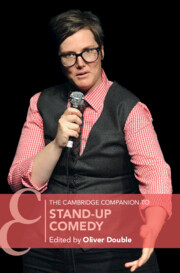Book contents
- The Cambridge Companion to Stand-Up Comedy
- Cambridge Companions to Theatre and Performance
- The Cambridge Companion to Stand-Up Comedy
- Copyright page
- Contents
- Figures
- Contributors
- Introduction
- Comedians’ Insights What Do You Do to Prepare to Go Onstage?
- Part I Time and Place
- Part II Interpretation and Meaning
- Part III Performance Dynamics
- Select Bibliography
- Index
Introduction
Published online by Cambridge University Press: 21 August 2025
- The Cambridge Companion to Stand-Up Comedy
- Cambridge Companions to Theatre and Performance
- The Cambridge Companion to Stand-Up Comedy
- Copyright page
- Contents
- Figures
- Contributors
- Introduction
- Comedians’ Insights What Do You Do to Prepare to Go Onstage?
- Part I Time and Place
- Part II Interpretation and Meaning
- Part III Performance Dynamics
- Select Bibliography
- Index
Summary
The Introduction starts by considering stand-up in Mort Sahl’s terms, as ‘a primitive form of theatre’. Using a quote by Tony Allen to pin down its key feature, it argues that stand-up is defined by centring on the performer themself, a direct relationship between performer and an active audience, and the appearance and possibility of spontaneity. After briefly considering the history of stand-up in the USA and UK, it goes on to recount the less familiar story of how it developed in Australia, from the emergence of Rod Quantock to the rise of the modern comedy club in the 1980s. It then considers its rapid expansion around the world in the last 30 years – paying particular attention to India, Estonia, and Belgium – and its continuing relationship with the English language even in non-anglophone countries. It finishes with an explanation of the scope and structure of the rest of the book.
Keywords
Information
- Type
- Chapter
- Information
- The Cambridge Companion to Stand-Up Comedy , pp. 1 - 12Publisher: Cambridge University PressPrint publication year: 2025
Accessibility standard: WCAG 2.0 A
Content Navigation
Allows you to navigate directly to chapters, sections, or non‐text items through a linked table of contents, reducing the need for extensive scrolling.
Provides an interactive index, letting you go straight to where a term or subject appears in the text without manual searching.
Reading Order & Textual Equivalents
You will encounter all content (including footnotes, captions, etc.) in a clear, sequential flow, making it easier to follow with assistive tools like screen readers.
You get concise descriptions (for images, charts, or media clips), ensuring you do not miss crucial information when visual or audio elements are not accessible.
Structural and Technical Features
You gain clarity from ARIA (Accessible Rich Internet Applications) roles and attributes, as they help assistive technologies interpret how each part of the content functions.
